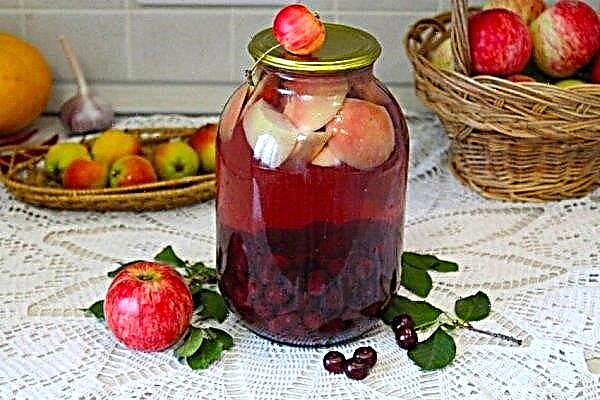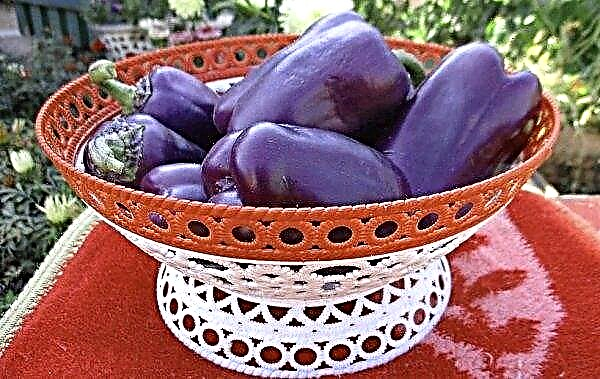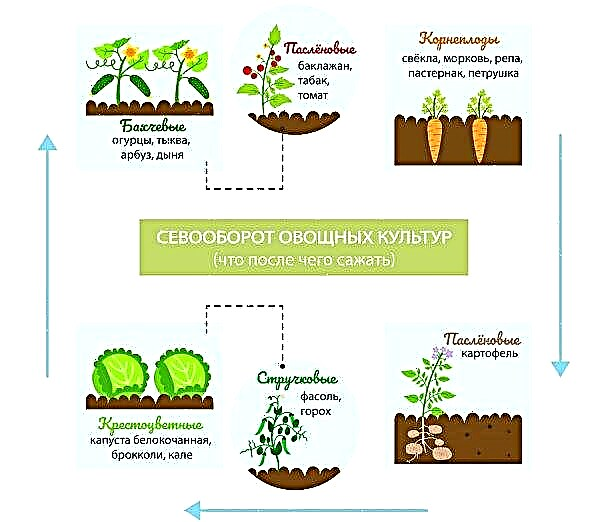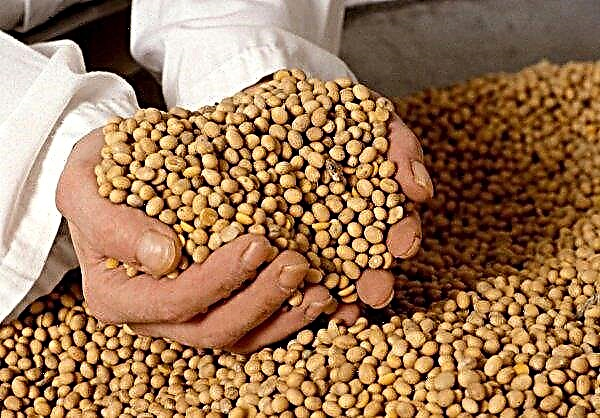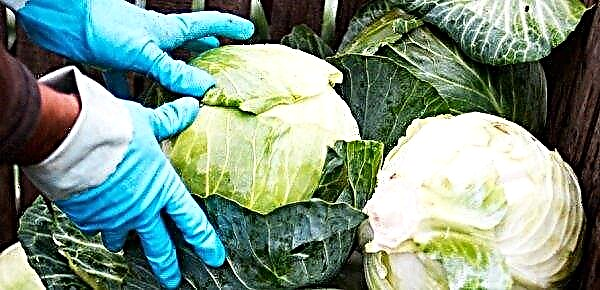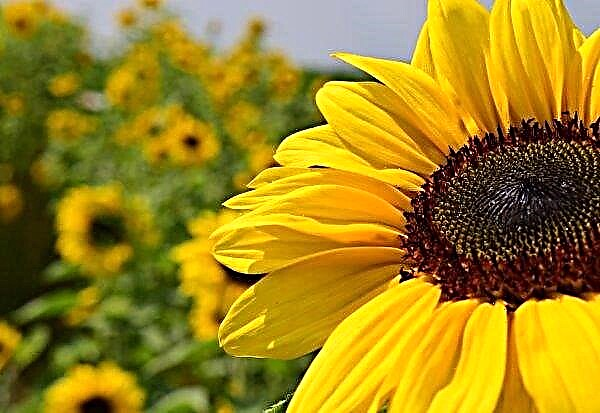Along with livestock farms with a standard set of cattle or poultry, ostrich farms are gaining popularity. Beneficial or not, the cultivation of ostriches at home and about the pitfalls of the project, read below.
Is it profitable to breed ostriches
Like any other business, ostrich breeding has its pros and cons.
Did you know? Taking one step, ostriches overcome 3-5 m.
Starting the management of such an economy, it is important to adequately evaluate them and outline an action plan.
Project Benefits
- The main advantages:
- project profitability (100-150% with the right approach to business), due to the high demand for products and good immunity of the bird, resistant to many diseases and well adapted to harsh winters;
- the possibility of selling not only meat and egg products, but also leather with feathers, which are most often purchased by factories for the production of various accessories (shoes, bags, wallets, boas, etc.);
- lack of restrictions for entering the national market;
- the opportunity to receive benefits, subsidies and other favorable conditions from the state, with the proper design of the business as a livestock industry;
- the popularity of exotic meat among healthy food clubs, sports organizations and high-end restaurants, which allows you to get a large individual customer.
Project disadvantages
- Among the shortcomings of the project are:
- high cost when purchasing poultry - large retailers require a rhythmic supply of products, as well as large volumes, so at the initial stage it will be necessary to immediately purchase several ostrich families;
- complexity of equipment of the ostrich farm itself;
- the complexity of registration through the tax and all other authorities;
- the need to hire staff when growing a large number of birds - ostriches are rather large-sized individuals, so one person can not cope with the care of them;
- the need to attract a qualified veterinarian.
The basic rules for successful breeding of ostriches
Where to start and how to succeed in breeding ostriches:
- Make a business plan.
- To study the market and its capabilities to compete in this market.
- Get permission to farm.
- To organize a place for keeping birds with quality equipped rooms for winter-summer keeping.
- Find a way out to a supplier of healthy young animals.
- To have a studbook is necessary to avoid inbreeding.
- Find an accountant, veterinarian, livestock specialists (people trained in poultry care, repairing equipment, norms and standards of sanitation on the farm).
- Find a way to the point of sale of the products.

Growing organization
An ostrich farm should be protected from all sides from the wind and be in a well-lit, unboggy area. Having picked up a site, you need to obtain permits from various authorities, including veterinary services, to organize a farm on it.
The site allocated for the arrangement of the farm has the following requirements:
- the type of soil allows you to build buildings without laying an expensive foundation;
- the site in the past is favorable in the veterinary plan - it is not marked in the list of territories where there were outbreaks of sporadic and enzootic outbreaks of infectious diseases;
- the site is located on the leeward side and below the level of housing estates;
- distance to residential and public buildings - 200 m;
- distance to farms with large and small cattle - 150 m, other types of poultry - 200 m;
- distance to rabbit / fur farms, processing of various and storage of various raw materials (vegetables, fruits, animal materials) - 1.5 km;
- distance to the tracks - 300 m;
- availability of access to clean drinking water.
After all preparations, you should select the type of content and scheme.
Important! Meat and egg products obtained from birds kept in cramped conditions are of low quality, which dramatically reduces its cost.
There are 3 types of content:
- Intensive - In relatively small areas, eggs are incubated, and young and adult individuals are also kept. The advantage is the quick adaptation of the bird to communication with staff, the disadvantage is the increase in hygiene requirements.
- Extensive - the bird is bred in a large area. With this method of keeping ostriches, most of the time they are left to their own devices, which brings conditions as close as possible to natural ones.
- Semi-intensive - a cross between the first and second methods.
 Content Schemes:
Content Schemes:- single-level - rearing of birds of the same age in a common area before slaughter or when they reach 3 months;
- multi-level - on one territory a livestock consisting of individuals of different ages is kept.
Farm arrangement
Having resolved all organizational issues, they begin to arrange the site.
To do this, you need:
- To outline the building plan with the designation of its internal arrangement.
- Make a marking of the site, designating areas for recreation and walking.
- Choose a highly productive breed of poultry - much attention should be paid to the adaptive abilities of ostriches.
- Make a list of the necessary feed for the winter and summer period, carry out appropriate purchases.
- Learn the rules for bird care.
Ostrich housing
Dimensions of the building depend on the planned amount of acquisition of birds.
They are calculated in accordance with sanitary standards, which require the placement of representatives of different ages in a certain area:
- young animals up to 3 months. - 2.5 m²;
- individuals up to 14 months. - 4 m²;
- over 14 months - 5 m².
 The inland should be delimited by separate sections for birds of different ages. The height of the building should exceed the growth of the tallest sexually mature individual by 0.5 m. On average, the growth of a sexually mature bird is 2.6 m, respectively, the height of the ceilings will be equal to 3–3.2 m.
The inland should be delimited by separate sections for birds of different ages. The height of the building should exceed the growth of the tallest sexually mature individual by 0.5 m. On average, the growth of a sexually mature bird is 2.6 m, respectively, the height of the ceilings will be equal to 3–3.2 m.When arranging rooms from the inside, it is worth considering the possibility of hygiene measures, so the walls and other elements should be smooth.
Awning structures are suitable as premises for keeping ostriches. Ostriches perfectly tolerate cold winters. The most important thing is to ensure the possibility of maintaining the temperature not lower than + 15 ° С indoors in winter. It is also worth taking care of the presence of a ventilation system.
Air circulation and microclimatic conditions are important when growing ostriches:
- air circulation speed in summer is not more than 3 m / s .;
- humidity level 60–70%.
The next nuance is the arrangement of the floor. For young animals and adults, you can make a concrete floor and cover it with a layer of straw. Particular attention should be paid to the litter for the chicks. They have an extremely developed pecking reflex, so the straw litter must be additionally covered with burlap.
Peeling straw can lead to the development of dyspepsia in chicks with a fatal outcome. When the chicks have reached ten days of age, the burlap is removed and the litter is loosened every day, in order to prevent its compaction and increase the drying rate.
The chick compartment must be divided into 3 parts for individuals with:
- high growth rate;
- secondary development;
- slow development.
 Separate pens in the room are needed, playing the role of insulators for the sick bird and the newly arrived at the poultry farm.
Separate pens in the room are needed, playing the role of insulators for the sick bird and the newly arrived at the poultry farm.Important! Each connecting block in the building on the walking area should be equipped with disinfection mats.
Placement of feeders and drinking bowls
When placing and arranging feeders, it should be borne in mind that the ostrich is a rather aggressive bird, and eats food very eagerly. In this regard, feeders and drinking bowls should be quite large and placed at the height of bird growth. In one compartment, several feeders and drinking bowls are installed.
Their dimensions are calculated depending on the age of the bird:
- for each chick - 50 cm;
- per adult - 1.5 m.
It is best to place feeders and drinking bowls away from the bird resting area.
As feeders intended for hay and twigs, trellised nurseries can be used. They are placed at a height of 70 cm from the floor. As drinking bowls, steady plastic troughs are suitable.
Land for recreation and walking should also be equipped with feeders and drinking bowls for the warm season.
Plot for resting and walking ostriches
From each compartment from the premises you need to make exits to the walking area. The area is calculated taking into account the age and dimensions of the bird:
The area is calculated taking into account the age and dimensions of the bird:
- chicks up to 3 months. - 50 m²;
- from 6 to 14 months - 100 m²;
- adults - at least 200 m².
The length of the pens should allow the adult to accelerate to full speed and brake without injuries. The optimum corral length is 40-60 m. In order for the bird to turn quickly during acceleration, the corral should be at least 20 m wide.
Proceeding from this, for walking an ostrich family consisting of 1 male and 2 females, an area of 800 m² is required.
For the winter period, the living conditions for adult ostrich families are changed, transferring 2-3 families to one pen. This allows the birds to gather in large groups and bask, which reduces the cost of heating the house.
Did you know? The average life expectancy of an ostrich is 40–50 years, with the females retaining the ability to lay eggs up to 30 years.
Between all corrals there should be 1.5–2 m wide safety connecting passages to avoid personal injury and to eliminate the possibility of male contact between themselves.
Breed selection
Today, a large number of ostrich breeds are known, but not all of them can be profitable and adapt to the conditions of our climate.
In our latitudes, the following breeds are most often bred:
The biggest profits come from birds belonging to the subspecies of the African ostrich:
Feeding
Food for ostriches should be varied. Fattening one individual before it reaches marketable weight requires 400 kg of high-quality compound feed. Ostriches are completely picky about food and very voracious, so you have to clearly regulate the amount of feed absorbed.
In the wild, the main diet of the bird is greens, seeds, insects and small invertebrates. The average daily feed for a young bird is 3-4% of its body weight, adult - 2.5%.
Ostriches are suitable for feeding poultry. Mineral complexes, including phosphorus and calcium, as well as coarse foods in the form of hay, twigs, silage and various greens (fruits, vegetables, various herbs) are added to them.
The need for feed will vary depending on age and physiological characteristics.
There are 3 sex and age groups, and differentiation of feed is carried out among 5:
- young growth - up to 2 months;
- individuals in the phase of active growth - 3-12 months;
- final diet - 13–36 months;
- females during the breeding season (active oviposition);
- adults in the winter.
Important! The more protein food is in the diet of the bird, which is in the phase of active growth, and the opportunities to move around actively, the better the meat will be.
After hatching from the eggs, the chicks are not fed for 3 days. During this time, they must fully realize the nutrients remaining in the intrauterine gallbladder. When hatching, it can be up to 25% of the mass of the chick. Access to drinking water is provided from 3 days of life. From 4 days begin to give crushed alfalfa and clover (pieces of 1 cm), mixed with compound feed for chickens with a protein content in the range of 19-24%. Along with this, a boiled egg, cottage cheese and coarse corn are introduced into the diet.
From 4 days begin to give crushed alfalfa and clover (pieces of 1 cm), mixed with compound feed for chickens with a protein content in the range of 19-24%. Along with this, a boiled egg, cottage cheese and coarse corn are introduced into the diet.
From 2 months, 18% protein and 12% fiber should be present in the diet of ostriches. In the summer, it is necessary to introduce greens, in the fall, replace it with root vegetables (potatoes only in boiled form, the rest in fresh). In the diet of ostriches from 3 weeks of life, gravel should be present. It is exposed in separate boxes.
Daily rate of feed consumption for birds of different ages:
- 1 month - 150 g;
- 2 months - 400 g;
- 3 months 750 g;
- 4 months - 950 g;
- 5 months - 1.2 kg;
- 6 months - 1.5 kg;
- 12 months and older - 2.5 kg.
In summer time
The main diet for summer time is green feed:
- alfalfa;
- feed cereals;
- nettle;
- quinoa;
- cabbage;
- spinach;
- gourds;
- carrot;
- bow;
- pears, apples;
- radish.
 As roughage in summer add:
As roughage in summer add:- soy;
- legumes;
- sunflower;
- cereals.
Did you know? The ostrich is capable of speeds up to 97 km / h.
As a substitute for products of animal origin, meat and bone or fish meal is added to the diet. To provide the birds with the necessary microelements, shell rock, eggshell, biocalcium phosphates and monophosphates are introduced.
Do not forget about free access to clean water. On average, one adult should have 6–8 liters.
In winter
In winter, the diet consists of:
- root crops;
- silo;
- hay;
- mineral additives;
- grain feed.
Bird care
In the compartment where the ostriches are kept, the air temperature at any time of the year should be within + 25 ° С. Humidity should not be lower than 65%. Focus should be on litter replacement. Do not allow her to bob. Replacement should be done every 2 weeks (more often). Once every 5-7 days.
Focus should be on litter replacement. Do not allow her to bob. Replacement should be done every 2 weeks (more often). Once every 5-7 days.
Tanks with sand must be installed in the premises. With it, birds clean their feathers. At any time of the year, birds should have access to the walking area. In cramped conditions, large-sized individuals often get sick.
For breeding birds, it is better to purchase an incubator, since ostriches enter the phase of puberty only at 2 years old.
From 4-5 days of life, all young animals begin to be vaccinated.
Ostrich breeding business plan
The first step to success is a competent bird breeding plan:
- Market research and the optimal ways in which all products will be sold.
- Planned production volumes.
- Analysis of the chain of constructing prices for products, taking into account the estimated profits and costs.
- Analysis of the benefits of business and pitfalls.
- Comparative characteristics of competitive products and a real assessment of their capabilities.
- Marketing strategy - setting prices, sales tactics, after-sales relations (providing a guarantee for the goods), promoting the goods on the market.
- Assessment of project financing ways.
- Obtaining all necessary permits for this type of activity.
- Hiring a site, its equipment, buying poultry, eggs, incubators.
- Hiring workers.
- Organization of poultry care and purchase of feed.
Important! At this stage of technology development, it is most beneficial to create an online platform with the announcement of the availability of products. In this case, customers will be able to come to you on their own, and not only domestic, but also foreign.
Approximate economic calculation of profitability
Cost items with approximate prices:
- purchase of land - 2 million p .;
- livestock (1 male + 2 females) - 1 million 800 thousand rubles;
- equipment for the farm - 2 million 800 thousand rubles;
- incubator - 70 thousand p.;
- boxing - 50 thousand p .;
- organizational expenses - 7 million p .;
- farm construction - 2 million p .;
- feed costs at the rate of 400 kg / year per individual - 400 × 3 = 1,200 kg - with feed prices of 20 r / kg, 24 thousand rubles are obtained;
- business registration - 20 thousand rubles;
- payment to employees - 15 thousand rubles / month. - 180 thousand issues per year
 Total results: 18 million 944 thousand rubles. If you need to get profit very quickly, then you need to buy immediately 25 families, which will have to spend 4.5 million rubles. In this case, the item of expenses will be - 15 million 944 thousand rubles.
Total results: 18 million 944 thousand rubles. If you need to get profit very quickly, then you need to buy immediately 25 families, which will have to spend 4.5 million rubles. In this case, the item of expenses will be - 15 million 944 thousand rubles.In the first year, income can only be obtained by purchasing a large number of ostriches - an average of 25 families. If you start only 3 individuals, all egg products will go to increase the number of livestock, which means that you will work all this period in minus.
Profitability depends on the quality of the products and on the ability to properly build business relationships. On average, such a business will pay off in 2-3 years if the number of livestock is increased - about 7 million out of the sale of products received from 25 families per year.
To make more accurate calculations, look at the information about product prices and distribution channels below.
Sales and distribution channels
Looking for distribution channels it is advisable to offer your products:
- elite restaurants;
- sports clubs;
- organizations and people who manufacture accessories;
- mineral processing plants for bone products.
Did you know? The ostrich is the only feathered creature with 2 toes.
Eggs
The cost of one egg varies within 800 r. On average, a female at the age of 2 years old lays 60–70 eggs per season. Total profit from the sale of eggs for the period of egg production is 48-56 thousand rubles.
Meat
The yield of pure meat from an adult weighing 120–160 kg is 90–100 kg. The cost of ostrich meat per kg is 1 thousand p., Respectively, 9–10 thousand p.
Feathers
The output of a pen from an adult is 2 kg. The price per kg is 2.5–3 thousand. In total, 5–6 thousand rubles are obtained.
Fat and skin
Carcass fat is about 10 kg. You can sell it at 450 p. / Kg. In this case, we get 4.5 thousand rubles.
The most valuable skin is obtained from slaughter of birds aged 12-14 months. Its marketable output is 1.6 m². On sale, the cost of such products is 8 thousand 700 rubles / m². As a result, receives 13 thousand 900 p. net profit.
Claws and beak
Claws and beaks can be sold in jewelry workshops or in factories for processing similar products into mineral additives. You can also start producing souvenirs from these products.
On average, 2-3 thousand rubles can be gained for the claws and beak of one individual.
Sale of individuals
Realization of individuals is carried out after they reach the age of 1 month. or 1.5 years. Starting price for an ostrich - 6 thousand rubles, a one and a half year old female - 30 thousand rubles, male - 34 thousand rubles.
Useful tips for beginners
Some useful tips for those who decide to open an ostrich farm from scratch:
- It is best to take individuals aged 1.5 years - after 5 months. the bird will enter the phase of puberty, and accordingly will begin to lay eggs.
- Make purchases in February-March - this will significantly reduce the cost of feed.
- Actively engage in advertising immediately after receiving the first egg products and young animals. When the clientele is developed, gradually reduce advertising.
 To breed ostriches in our country is quite profitable.
To breed ostriches in our country is quite profitable.Did you know? To get the same amount of omelette as from one ostrich egg, you need 25-30 pieces of chicken.
After an average of 2.5 years, a business fully pays for itself and begins to provide a stable profit.


